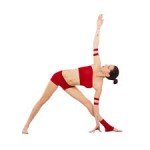
As I mentioned in the last article on lymphedema, I am dealing with it at the moment. It is not difficult to make out that these are not the best days for me but anyways I am trying to work my way out of this. This is not my first time and I know if I have done it before I can do it this time too.
I enjoy doing yoga for numerous reasons. Once again for dealing with lymphedema, I seek solace in my practice. In this article we discuss a few asanas that can help in reducing water retention.
I have had to make a few adjustments to my diet and lifestyle. My water intake has always been high and salads an integral part of my meal. A high protein diet devoid of salt is a norm these days. I have been practicing yoga for more than two years now. I find solace in

my practice rather it helps me regain strength both in my mind and body to deal with many things. Due to my hysterectomy a few months back, it was obvious that I discontinued my practice and when I did start after a rest of three months it was only with very basic asanas. I am trying to regain my entire range but is taking some time or rather a longer time than expected. But now I think it is time to get back to the full range.
Trust me, if not doing away with the issues altogether, it will help you find your legs. The idea is to stretch the legs or the affected body part well. It is important to work to improve blood circulation to various parts of the body.
Some of the asanas that can help deal with water retention are:
- Tadasana/Mountain Pose: The asana improves circulation of blood in the legs. It provides a deep stretch to the muscles and nerves which leads to reduction in fluid retention in the body. The asana stretches all muscles right from the toes to the head. Do the asana for 30 to 60 seconds.
- Vrikshasan/Tree Pose: The asana is one of the most important asana in the practice of yoga. While improving concentration it improves the circulation of blood and reduces the hances of water retention. Do the asana for 30 to 60 seconds with both legs.
- Veerbhadrasana I/Warrior I Pose: Performing the asana involves nearly whole of the body. The hands, arms, abdominal muscles, the spine, buttocks, thighs and calves all are involved while in the asana. The result is that blood travels to all these parts. An intermediate pose it helps build strength.
- Utthita Parshavkonasana/Extended Side Angle Pose: The pose gives a deep stretch to the ankles, knees, thighs and hips along with the groin area, the spine, the lungs and the shoulders. It improves stamina and builds strength all through the body.
- Viparit Karni/Legs up the wall pose: A restorative pose, it stretches and activates the abdominal muscles. It helps eliminate excessive fluid from the abdominal region. It helps eliminate pain in the feet and the legs.
- Sarvangasana/Shoulder Stand: This is the queen of all asanas. It provides a complete stretch to the abdominal muscles. Provides a complete stretch to the body and the heart muscles.
- Halasana/Plough Pose: The asana provides a complete stretch to the stomach, the legs and feet. Works well to alleviate the symptoms of water retention.
- Surya Namskar/Sun Salutation: One of the best

Surya Namaskar cardiovascular exercise, it works the entire body. It stretches and flexes the entire body and tones the muscles. It helps relax the mind.
In addition to the above asanas, Setu bandha asana, asvasanchalan asana, katichakrasana, chakrasana, trikonasana and bhujangasana can be added to your daily practice.
For inversions it is best to confirm with your trainer as to when you can start with them after a surgery.
Anyone else who has read about my discomfort will probably say – ‘big deal girl! Apply some moisturizer and go shopping for loose fitting clothes! Relax!’
We know that the solution does not lie in the above suggestion. It requires much more than shopping and moisturizer. In the doctor’s language that it just symptomatic treatment of the problem at hand.
So where is the solution?
For me the solution lies in the statement –
‘When the going gets tough, the tough do yoga!’
The above asanas are only a recommendation. It would be best to consult your doctor if you can do yoga at all and your trainer about what all asanas you can practice. Do not overstretch and respect your body. You will not get results in a day or for that matter a week. Be patient.
It would be best to incorporate exercise along with dietary and other recommendations made by the doctors.








